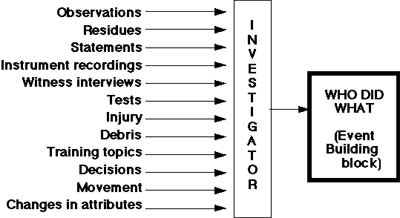Investigation Task Help
© 2004 by Starline Software Ltd.
|
|
INVESTIGATION CATALYST Investigation Task Help © 2004 by Starline Software Ltd. |
ACQUIRING EVENT BLOCKSThe challenge: transform observed data into useful information. DOCUMENTING OBSERVATIONS An investigator must be able to acquire and transform observed investigation data into the documented building blocks needed to develop investigation work products. This documentation challenge generally stated is to:
|
| Data Language |
The fundamental component of the MES process is the data language on which all other elements depend. This data language is defined by the Event Block (EB). An EB is one action by one person or object, or 1 actor + 1 action = 1 Event Block. For investigations, action should be active voice, past tense. For system operation description, action should be active voice, present tense. |
| Data Tramsformation |
The EB creation task is to create EBs from whatever data can be acquired from any sources during the investigations. Investigators explore surviving sources for data they can transform into EBs. The data preserved in the source is acquired and absorbed by the investigator, who processes it to produce EBs. Many sources may have captured and preserved data about the phenomenon, as shown below: |
| The Investigator's Data Transformation Task |

|
| Reading data sources |
Extracting EBs from each kind of source requires common skills but different knowledge about the sources. For example, to acquire EBs from a person or object, investigators need have the skill to develop questions to ask, to visualize the data they get as a "mental movie," which is a form of reproducing the process, to document and verify the data they acquire, and to "read" people during interviews or objects during examinations. |
| Change analysis tool |
Change analysis is another tool that investigators can use to identify the changes
of state that occurred during an occurrence, and the actors and actions that produced
those changes of state. With change analysis, the investigator compares the state before
and after the occurrence to identify the change(s) that occurred. As each change is
identified, data is examined to try to determine who did what to produce the change.
The method and an example of its application is provided by Starline at |
| Expert help |
Extracting EBs from objects may require expert help from people who know the systems and their behaviors, or testing of some kind to read the data which the object contains. See the next section for test plan design. In addition to people and objects, energy may provide a source for new EBs because
energy can and does do work which affects people or objects or what they do. For more
information about acquiring EBs from energy, see |
Previous | Next | Help Menu |